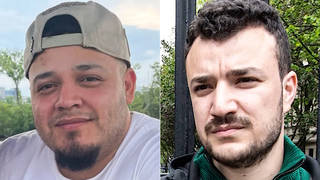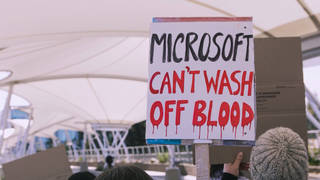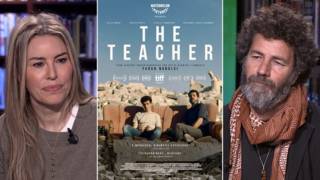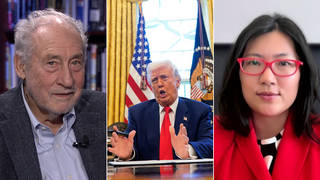
In Part 2 of our interview with Nathan Thrall, former director of the Arab-Israeli Project at the International Crisis Group, now a writer based in Jerusalem, he discusses his acclaimed piece for The New York Review of Books, “A Day in the Life of Abed Salama: One man’s quest to find his son lays bare the reality of Palestinian life under Israeli rule.”
Transcript
AMY GOODMAN: This is Democracy Now!, democracynow.org, The Quarantine Report. I’m Amy Goodman, with Nermeen Shaikh, as we bring you Part 2 of our conversation with Nathan Thrall, former director of the Arab-Israeli Project at the International Crisis Group, now a writer based in Jerusalem. His latest piece for The New York Review of Books is headlined “A Day in the Life of Abed Salama: One man’s quest to find his son lays bare the reality of Palestinian life under Israeli rule.”
Now, this article has had an enormous impact. Congressmember Ro Khanna sent it to about a hundred members of Congress, the whole Progressive Caucus, and it has been read around the world. Nathan Thrall, thanks so much for staying with us. In Part 1 of our discussion, you began to talk about this story. But it needs to be told in full. It is a microcosm of life in Israel and Palestine. Talk about the day of the crash, who Abed and Milad Salama are.
NATHAN THRALL: So, thanks so much, Amy.
This is — as you say, it’s a horrific story that all takes place in one day. And it’s meant to be much more than that, because the obstacles that Abed, the father, faced during that day, they go back not just to the 1967 War, to the annexation of Jerusalem, but actually to the entire history of this conflict, to the beginning of Zionism. And the piece attempts to encapsulate all of that through the story of this tragic day in Abed’s life.
Now, to understand what happened, I need to describe first where Abed and Milad lived. And where they lived is in an enclave. There are several such enclaves. That is, part of the enclave is within municipal Jerusalem. It’s a Palestinian enclave that is separated by the 26-foot-high concrete gray wall that Israel calls a “separation barrier” — some people call the “apartheid wall.” And on three sides, this wall surrounds a densely populated Palestinian set of communities, one of which is the Shuafat refugee camp, which houses Palestinians who fled West Jerusalem, or were expelled from West Jerusalem during the 1948 War, and now live on the other side of the wall and have to go through a checkpoint just to get to the downtown of their own city. They’re taxpaying residents of the city of Jerusalem, and they’re walking through a checkpoint, manned partly by the army, as though they are hostile forces entering, you know, some other state than their own city, the city that they live in and pay taxes to. The Israeli state completely neglects this area. It’s lawless. There are almost no services. The streets are, you know, potholed, without sidewalks. Really, it’s a ghetto. And it’s surrounded on three sides by this wall. A fourth side has another wall, which is a different wall, which is a wall that runs through the middle of what’s known as the “apartheid road.” It’s called that because it has separate lanes for Israeli and Palestinian traffic, and there’s a large wall running through the middle of it so that the two sides cannot see one another.
And inside this enclave, half of it is municipal Jerusalem, which means that those people have the right to go through the checkpoint and enter the rest of the city. The other half live in the town of 'Anata, which is where Abed and Milad lived. Now, within this enclave, you're officially crossing — when you walk within it, you’re officially crossing from the sovereign state of Israel, because it’s the annexed part of East Jerusalem, to the unannexed and occupied West Bank. But, in fact, people move around inside this enclave. They live together. They marry one another. They’re parts of the same families. They attend to the same schools. And it causes enormous problems for them, because, for example, if you are a Palestinian woman living inside the Jerusalem part of the enclave, in the Shuafat refugee camp or the parts of 'Anata town that were annexed, a neighborhood called Dahiyat As-Salam, then Israel is constantly trying to find a way to remove your right to live in Jerusalem and to enter the rest of Jerusalem. And so, if you were to move outside this area — you marry a Palestinian man who has a green ID, he's a West Banker, he lives a few blocks away from you in the same enclave — if you were to move away and Israel finds out, they can remove your residency, and you can’t see your family on the other side of the wall in Jerusalem anymore.
And so, it’s an enormously precarious life that people in this enclave live. And Abed has family members who have blue IDs. He himself has a green ID. And his son Milad attended a school that had both green and blue ID holders within it. And because of that, these kids couldn’t — there’s no playground around. These kids couldn’t go to the nearest play area, which is just on the other side of the wall in the settlement of Pisgat Ze’ev inside annexed East Jerusalem, a Jewish settlement. Really, just the people of this camp are looking — of Shuafat camp are just looking directly on the red-roofed buildings of the Pisgat Ze’ev neighborhood, homes that sell for a million dollars in this neighborhood. And they are looking on a shantytown from — the Jewish residents of this settlement are looking on the shantytown of the Shuafat camp.
Now, one morning, the school took a field trip. And because they couldn’t take a field trip to the nearest play area, which is just, you know, on the other side of the wall, they had to follow the circuitous route of the wall, winding their way up north and to the West Bank toward Ramallah, where they were all going to have a play day at a play area in Ramallah. And on their way, a truck, a massive tractor-trailer, that was ferrying back and forth to a settler-owned West Bank quarry — and this settler tractor-trailer slammed into the bus, and the bus caught fire. And this is right next to a checkpoint. They are minutes away. Soldiers are standing right there. There are settlements that surround the entire area. Flames are rising. Gray smoke is rising. Everyone in the area knows something terrible has happened. And it takes a very, very long time for any kind of rescue to come. The first rescue that does come is actually a Palestinian ambulance from Ramallah. Part of the story I tell is of the first paramedic who came on the scene.
And Abed, he’s stuck in this walled ghetto. His son is outside of it. He has no idea what happens. He’s just hearing rumors that there was an accident with a bus. He doesn’t know if it’s his son’s bus. He doesn’t know anything. And he races to try and get there. He’s stuck in horrible traffic. He gets out of the car. He races up on foot to try and go toward the smoke. He asks soldiers next to the checkpoint if they will give him a lift. He says his son’s on a bus. He thinks it was in this accident. They refuse. He runs to go and find — and by the time he had gotten there, the people on the bus, the teachers and the students, were gone.
And he is now hearing all kinds of rumors. He has no idea what’s happened to his son. He doesn’t even know which hospital he’s in. Is he in Ramallah? Is he in Jerusalem? Abed can’t enter Jerusalem. He has a green ID. Many of the students on the bus, they have blue IDs. They can enter Jerusalem. He doesn’t know what to believe. He runs to a hospital in Ramallah. And on and on the story goes, through this horrific day.
And as I tell the story of Abed’s quest to find his son, I also describe the history of the settlements that were built in this area, the history of the quarry. You know, it’s illegal to pillage. It’s a war crime. And Israel has a number of quarries in the West Bank where it’s extracting natural resources. And many of the roads in Israel are paved with those stones.
And so, I could recite the whole story, but I would like people to read it and not to give too much away. But really, the attempt here is to describe the life of Palestinians as it is now, and as it has been for decades, and just how crushing the Israeli rule over them is.
And I also discuss the other side of it, which is the Israeli justification for this oppression and the justification for taking over the land in the West Bank, which is, by the way, the same justification that was used by Israel to take over former Palestinian towns inside Israel proper after the state was created and to found the Zionist movement. There is incredible continuity there. And we see it today in Sheikh Jarrah, the same justification being used by the two deputy mayors of the city, saying, “Well, of course, we have this discriminatory law in place that allows us to slowly have Jews take over Palestinian areas, because what do you want? This is a Jewish state.”
NERMEEN SHAIKH: But, Nathan, your piece is really quite remarkable. It is extraordinary, though, the reception that it’s received. It’s, of course, you know, fully justified, but it’s not just that, as we mentioned earlier, that Democratic Congressmember Ro Khanna has circulated it in Congress to the Progressive Caucus, but also, you know, from Nobel laureates, South African Nobel laureate J.M. Coetzee, Archbishop Desmond Tutu, but also several prominent figures within Israel, including a former ambassador, the chair also of Jewish history at UCLA, who’s the board president of the New Israel Fund, and David Shulman, who is an Israel Prize recipient. Could you talk about the reception of your piece in Israel itself?
NATHAN THRALL: Well, it’s been a tremendous honor to have these towering figures to read the piece and to speak of it in this way. You know, in Israel itself, it has not yet been translated into Hebrew. I would like that to happen. And I’ve gotten some great feedback from a number of Israelis, including the former speaker of the Knesset endorsed the piece. And that was attached to Ro Khanna’s letter, his endorsement, as well as to former Israeli ambassadors to South Africa and others. But I’d like it to reach a much wider audience in Israel with a Hebrew translation.
AMY GOODMAN: What do you see can happen at this point, as we begin to wrap up, Nathan, in Israel-Palestine with this latest conflagration that people are talking about could escalate into full-scale war? You have a sitting prime minister who is on trial for corruption. He can’t pull together a coalition government. Is he fueling this? And the U.S. response of President Biden and the U.S. Pentagon chief saying we have “ironclad” support for Israel, though saying Palestinians should be able to live?
NATHAN THRALL: So, I think that one of the unique things about the moment that we’re in today is that you have mainstream figures, on the left and the right, all saying, in one way or another, the same thing, which is, there is no — not only is there no two-state solution imminent or even on the horizon, there’s no solution imminent or on the horizon. You hear that — you know, you see it in reports from the Center for a New American Security, from the Carnegie Endowment, from the International Crisis Group, across the board, and even figures on the right, from the Trump administration, figures associated with the Obama administration. Everybody agrees that nothing — there is no solution that’s happening, even on the horizon, not just tomorrow or during Biden’s second term, if that should happen, but not even visible in the decades to come.
So, what that means is that the U.S. is giving $3.8 billion per year to continue a situation in which millions of people are being deprived of basic rights, of civil rights, of political rights, based on their ethnicity. That is called apartheid. And it’s unacceptable that the U.S. is giving a penny to this. And that needs to change. Before we talk about any kind of solution or get into the weeds of Israeli Prime Minister Netanyahu and his difficulties and what have you, what really needs to happen is an appreciation of a system of Israeli control, 90% direct administration of the land by Israel, 10% of it in these so-called autonomy enclaves, disconnected from one another, 165 of them, plus Gaza. That’s the situation on the ground, where these people have no rights, and they don’t have any prospect of gaining rights. And that is something that, at the very least, U.S. taxpayers should not be complicit in.
And in the future, I am confident — I am confident that all right-thinking liberals and progressives will say that they were always opposed to this and that they had always been, you know, against U.S. support for a system of oppression and apartheid. But we don’t see them behaving that way right now. And so, the bare minimum we need to see is to have people just call their congresspeople and say, “I don’t want to pay for this. I do not want to be complicit in what’s happening here,” at the very least end our own complicity. Before we talk about what good the U.S. can do, let’s talk about how the U.S. can stop doing harm.
NERMEEN SHAIKH: And, Nathan, as far as that is concerned — stop doing harm — do you think — the Biden administration has now dispatched a special envoy, Hady Amr, to the region to meet with, as they say, leaders of both sides. Could you explain what you think is likely to happen or the significance of this? And what exactly do they mean when they say “leaders of both sides”? Does that mean that they would meet the leader of Hamas?
NATHAN THRALL: A very good question. No, it does not mean that they would meet the leader of Hamas. It means that the U.S. envoy will meet — the deputy assistant secretary of state for Israel-Palestine will meet with PA officials, maybe with President Abu Mazen, and with Israeli officials. It’s not clear how senior, because Hady Amr is — you know, a deputy assistant secretary of state is a very low-level position. It doesn’t require Senate confirmation. And so, I don’t know at what level he’ll be received by the Israelis and at what level he’ll be received by the Palestinians.
But it doesn’t matter. You know, the U.S. is — its only objective is to get us back to where we were a week ago. Can we just go back to the quiet, to the system of Israel’s slow takeover of the land, of what land remains of Palestinians, while we, you know, talk about one day in the future we hope that there will be peace? And so, you know, these efforts will be narrowly focused on how do we get Hamas to stop firing rockets and how do we, you know, try and restore some sense of calm in the area under Israel’s control. So, this is an effort in — basically, Israel is facing an uprising; the U.S. is coming to try and help quell the uprising for Israel. And it’s as simple as that. I mean, Hamas — this is going to — Hamas’s rockets, they can’t go on indefinitely. It’s going to end at some point, you know. So, the U.S. can attempt to accelerate the end of the exchange of fire between Hamas and Israel, but it’s not really going to do much more than that.
AMY GOODMAN: Nathan Thrall, we want to thank you for being with us. And we’ll also link to your latest piece in The New York Review of Books, “A Day in the Life of Abed Salama: One man’s quest to find his son lays bare the reality of Palestinian life under Israeli rule.” Nathan is based in Jerusalem.
To see Part 1 of our discussion, go to democracynow.org. I’m Amy Goodman, with Nermeen Shaikh. Thanks so much for joining us.











Media Options